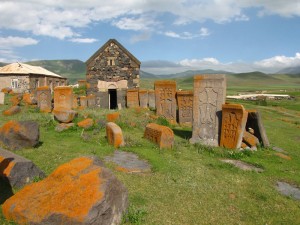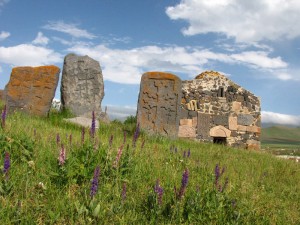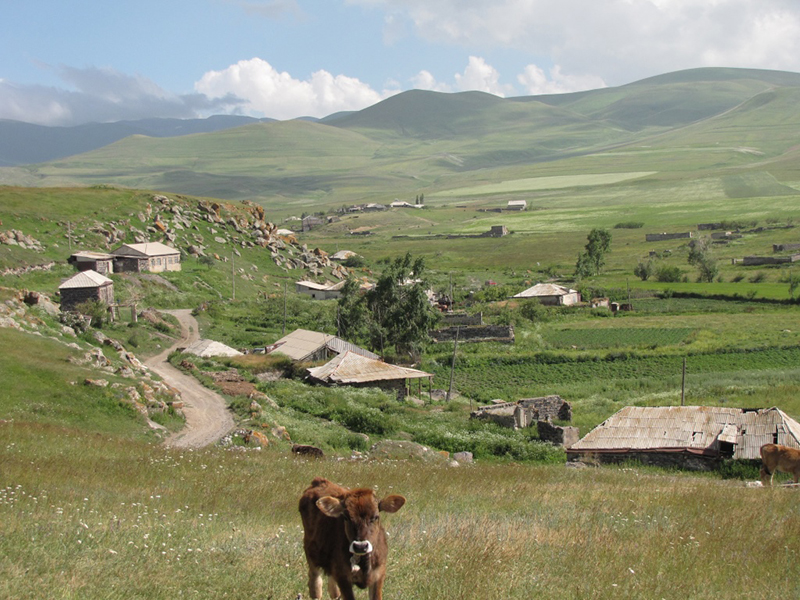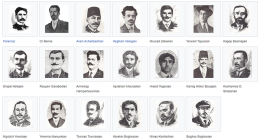By Hovsep Daghdigian
Ayrk, in Gegharkunik Marz, is a village of about 50 households about 30 km south of Vartenis, to the south-east of Lake Sevan. It is reachable from Vartenis by a bad but passable road.
The origin of the village is unknown but in the cemetery next to its two small churches, Soorp Grigor and Soorp Astvatsatsin, some of the khachkars (stone crosses) are dated to the 7-10th c indicating the village was in existence at that time.
Approaching the village a few roofs over the scattered houses were visible in the distance, together with some destroyed buildings. We wondered if there was really anything there and if continuing on would be worthwhile. An approaching driver assured us that there were two churches in the village, so we proceeded.
The village is poor, most of its young people leave for work in Russia. Current villagers are primarily refugees from Azerbaijan, with a few descendants of survivors of the Armenian Genocide in western Armenia. The primary economic activity is raising animals, and farming grain and potatoes. The climate is too cold to grow fruit. In the valley below Ayrk is a milk processing facility which processes and delivers the village’s milk to market.
We arrived at the two churches, about 100 yards apart, in mid-afternoon with bright sun, a cool breeze, and a few beautiful white fluffy clouds floating overhead. The two churches are small, simple rectangular buildings, about the size of my kitchen, and are not ornate apart from the interesting khachkars embedded in their walls. The ground is rocky with bright short green grass speckled with very small bright blue flowers. The green grass extends to the surrounding mountains and the shallow valley below. The field stones and khachkars in the cemetery are covered with fluorescent orange-colored lichen. It is one of the most beautiful, spectacular scenes I’ve seen in Armenia, or anywhere else for that matter. One of the villagers, an elderly gentleman, was seated on a nearby rock watching his flock of sheep. After a few words of greeting, it was as if we had known each other all our lives. He was a refugee from Baku.
The old Armenian name for the village was “Karakert”, meaning “stone built”. Sometime around the 15th c Turks settled in the area renaming the village Dashkert (meaning “stone built” – the same meaning as its previous Armenian name). Many, if not most, of the Armenians had left. After the Armenian Genocide some refugees from western Armenia resettled there, perhaps during the first Armenian Republic established in 1918. During the first republic and the subsequent Soviet era, though the village remained within Armenia’s borders, it retained its Turkish name due to the presence of its Turkish/Azeri inhabitants. As this was still part of Armenia the Turkish residents, as far as I understand, left the churches and cemetery undisturbed. Around 1988, during the Karabagh conflict, the Turks left. Armenian refugees arriving from Azerbaijan used the abandoned Turkish houses as sources of building material to build or repair their own homes. The village youth erected the khachkars, which over the centuries had fallen, placing them on solid cement bases. The current Armenian government renamed the village Ayrk.
This is a beautiful site, well worth visiting if one is a bit adventuresome. It’s about a 2 – 2 ½ hour drive from Yerevan, depending on the driver and car. The road to Ayrk runs along the south shore of Lake Sevan, passing the beautiful 9th c Ayrevank monastery which is right off the highway, and the Noraduz Cemetery with its spectacular medieval khachkars. The Noraduz cemetery is a 10 minute diversion from the main highway along Lake Sevan’s south coast and has visitor amenities.
Ayrk could become a tourist attraction providing at least some help for its economy. This superb and unvisited site should be promoted and, moreover, protected as a cultural preserve, perhaps under U.N.E.S.C.O. auspices.














